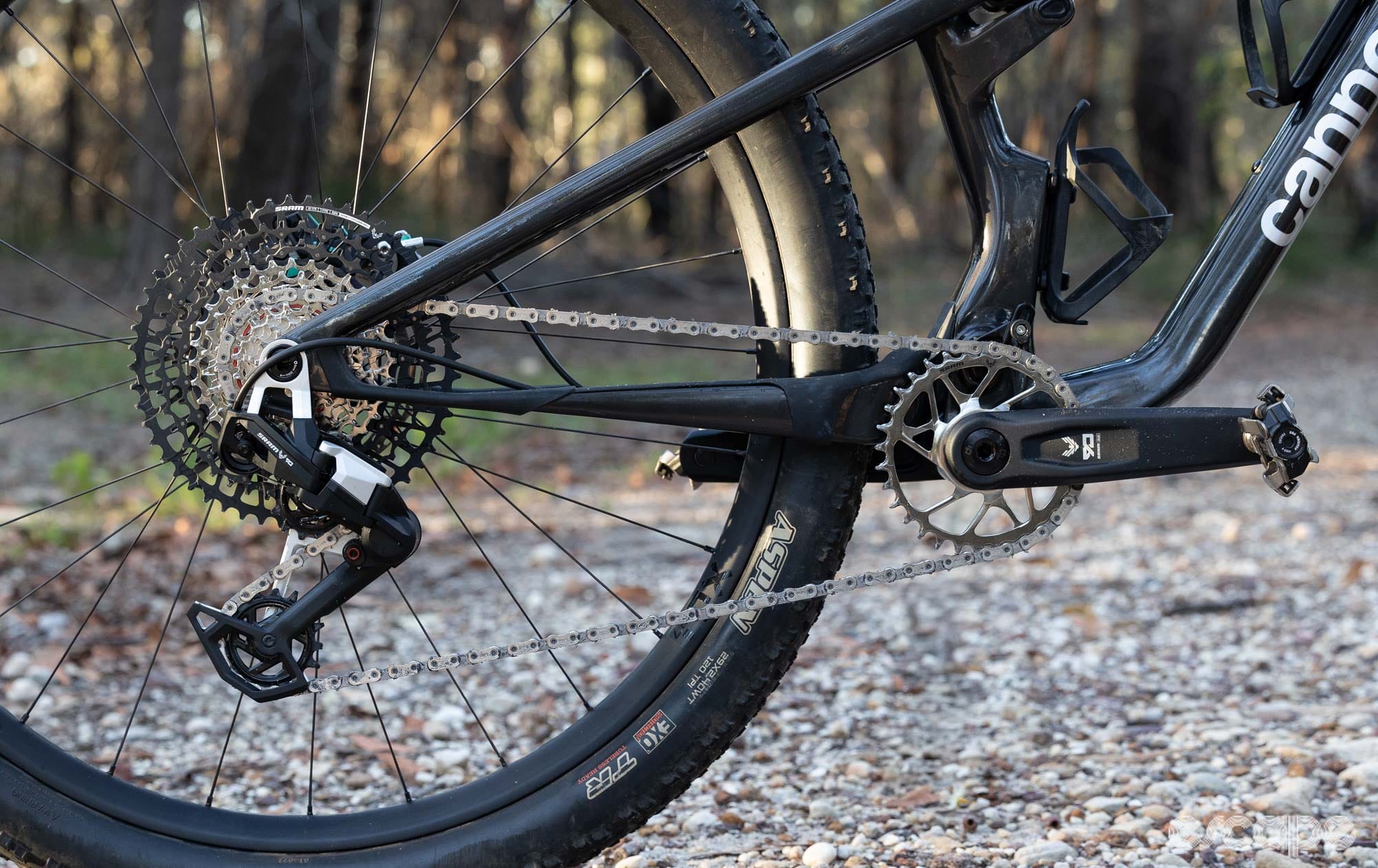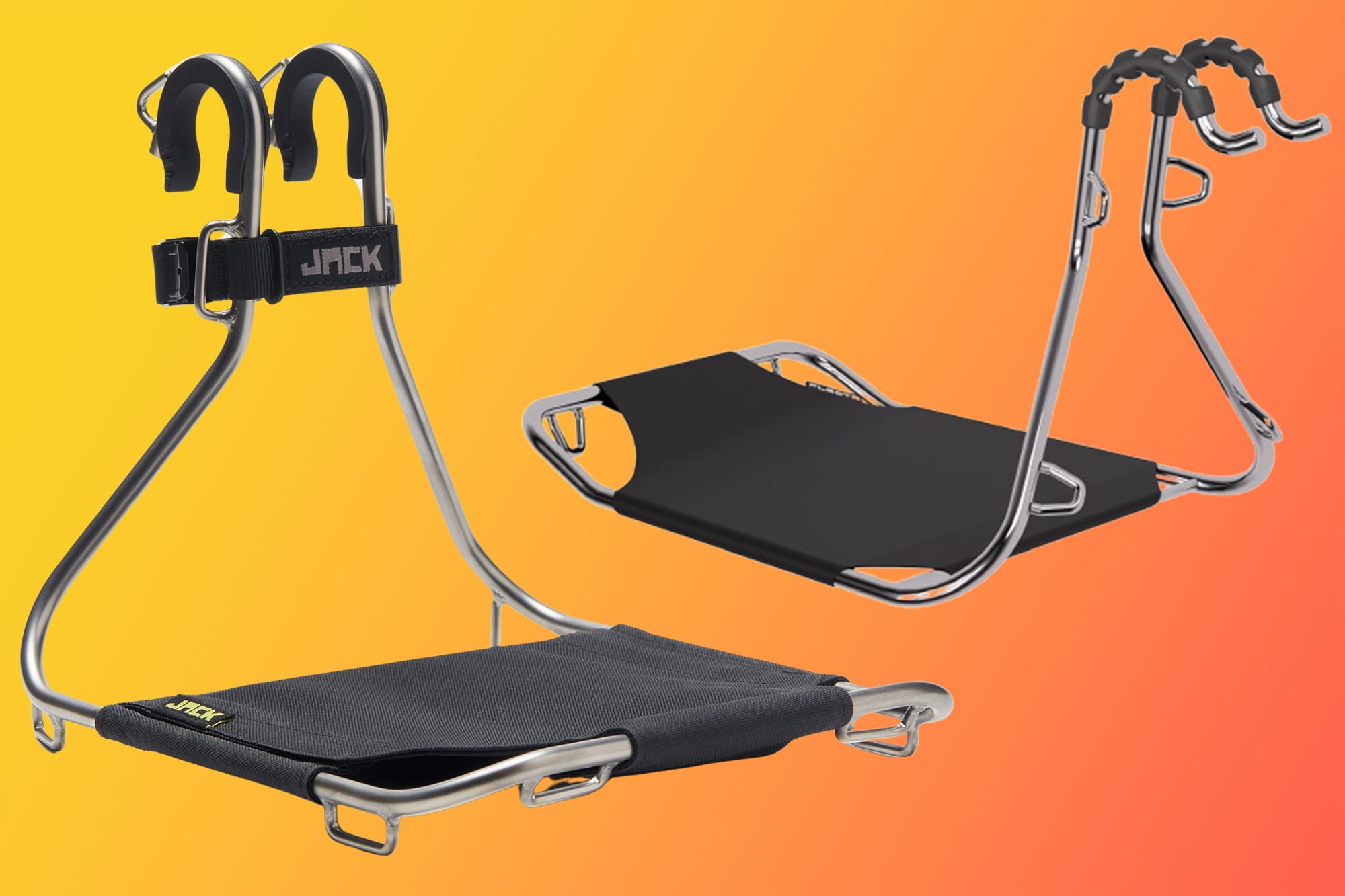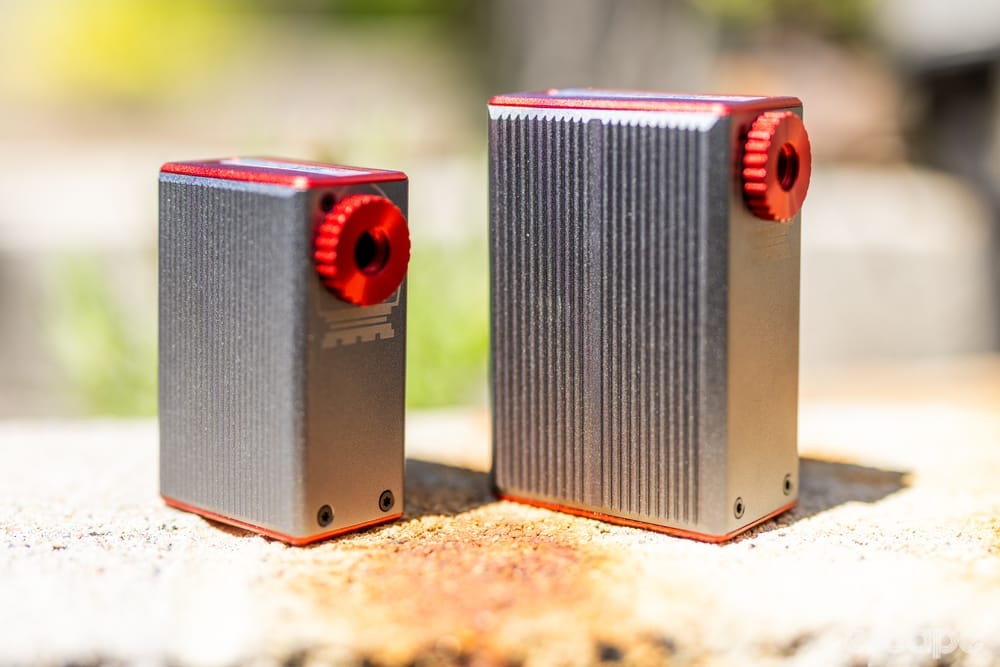Only a few years ago, there were strong rumours suggesting the future of SRAM drivetrains was all battery-powered beep-boop. More and more bikes were going thru-headset hose routing or just ditching routing for mechanical shifting altogether. It’s not that electronic shifting is bad, rather, having a choice is better – especially when money isn’t endless.
Thankfully, we were then given glimmers of hope, at least at the more budget-conscious end of the market. In 2023, SRAM released Apex in both wireless electronic and mechanical 1x12 variants for gravel, and it gave a cable strand of hope for something similar in mountain bikes, buttressed by detailed intellectual property filings and the occasional grainy prototype-in-the-wild photo.
Today, that cable-driven version of Transmission is no longer just patent drawings. Sitting at a lower-to-mid-tier price point for mountain bike components, SRAM has released its new 1x12-speed Eagle Mechanical Transmission. There are two price points, 90 and 70, both of which are priced beneath the current SRAM GX Transmission AXS, and are set to take the place of pre-existing GX and NX mechanical parts.
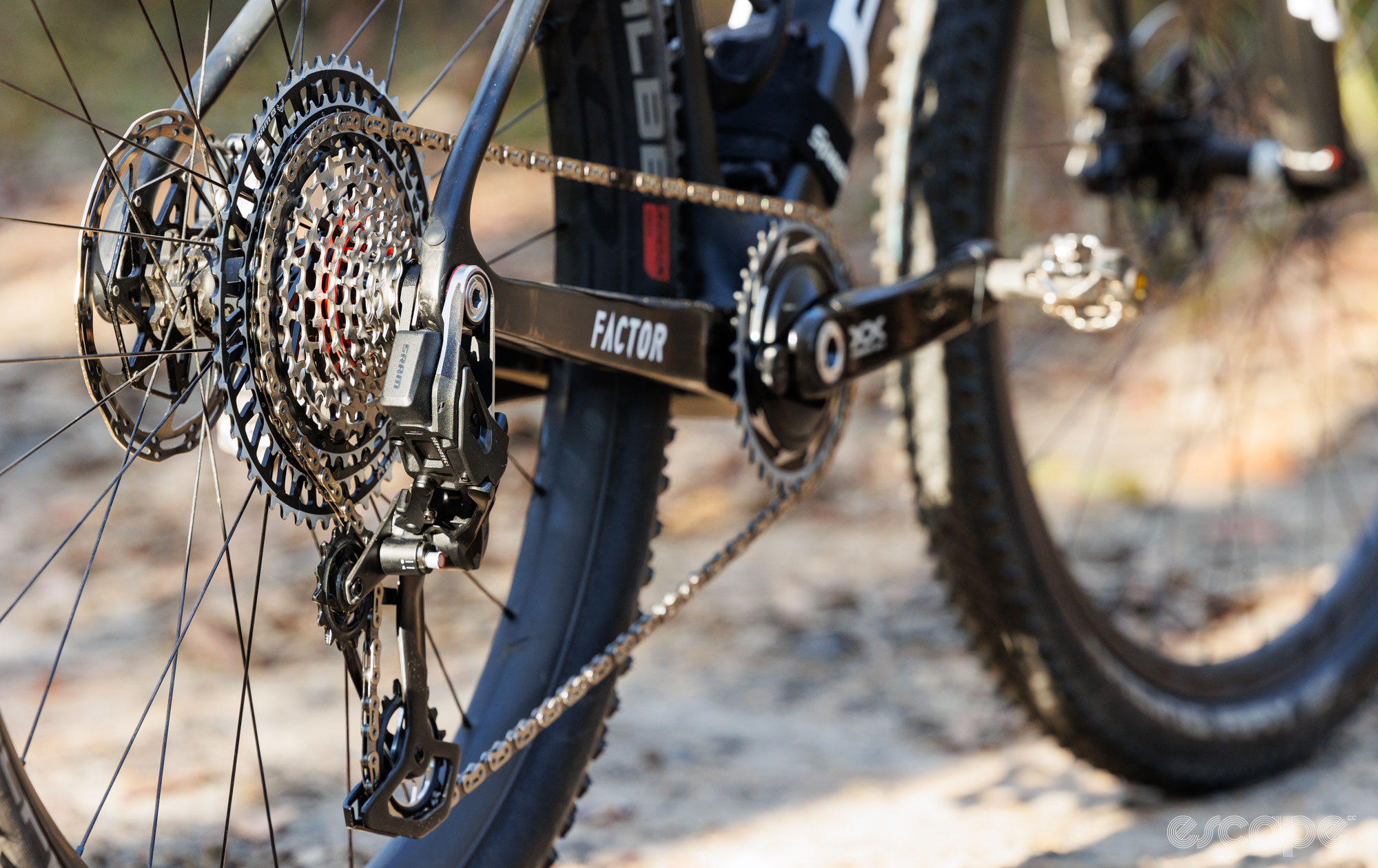
In a nutshell, if you’re familiar with SRAM's existing Eagle Transmission AXS systems and the Full Mount rear derailleur, then you largely know the story around this new Eagle 90 (and 70) Mechanical Transmission. Many of the technologies are shared, in fact, some of the parts, such as the 10-52T cassettes, are identical. However, instead of being controlled via batteries, servo motors, and a wireless protocol, you have an old-school gear cable pulling the derailleur into place. And if you’re familiar with SRAM Transmission, then you’ll probably also know that so much of that mountain bike tech was then applied to SRAM’s new Red XPLR dropbar stuff. Perhaps something similar will hold true for these new mechanical products.
My colleague Josh Weinberg and I have only recently begun testing these parts (along with the new SRAM Motive brakes). For now, I’ll detail what’s new, what isn’t, provide you with insight in compatibility and installation, along with sharing some early ride impression notes. The basic overview is free for all to view, but you’ll need to be a member of Escape Collective for my more detailed analysis. Also, expect the full review in future to update this article rather than replace it.
Not a fan of reading? A lot of what’s covered in this article was also discussed in a special episode of the Geek Warning podcast with some key people behind the creation of this product and the new brakes. There’s a bonus member-only section after the SRAM interview, where Josh and I then discuss the product. If you want to know it all, it’s worth consuming both the podcast and this article.
Highs: Brilliant shifting under load. That same solid hangerless derailleur interface. No battery charging to think about. Good cross-compatibility with other Transmission parts. Largely rebuildable derailleur. Simple step-by-step install process. Cables live on!
Lows: Shifter is a reminder the group is made to hit a price point. Cable maintenance, quality, and frame routing directly factor into shift quality. Narrow-wide cassette design can mis-shift when soft pedalling or demanding multiple gear shifts. Not as set-and-forget as SRAM’s AXS wireless.
Price: US$670 / €730 / £655 for a complete Eagle 90 Transmission groupset, as tested.
Since when does a bicycle have a Transmission?
It was exactly two years ago that SRAM released Eagle Transmission AXS. From afar, it was still a derailleur-based system built around a single chainring and with the same number of gears (12) and the same 520% gear range (10-52T cassette) as SRAM’s Eagle drivetrains before it. It was also built on SRAM’s AXS wireless system, meaning it could be controlled with any other SRAM AXS shifter, whether mountain bike or drop-bar.
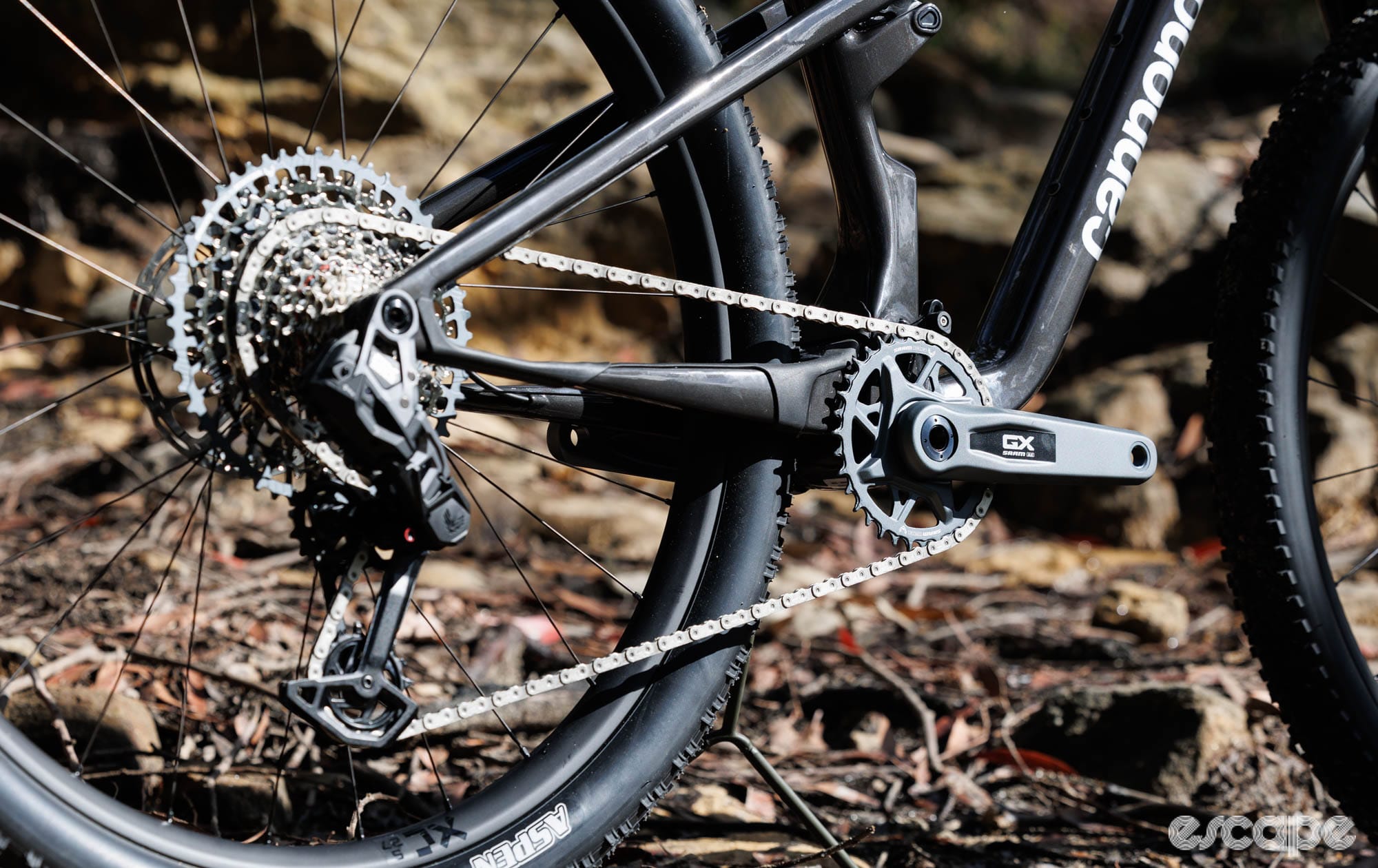
While some of the figures were the same, it also introduced a whole new way of mounting the rear derailleur. Transmission was the debut of SRAM’s Full Mount system, a rear derailleur that directly took the place of a Universal Derailleur Hanger (aka UDH, another SRAM creation). With the hanger removed, the Full Mount rear derailleur sandwiches the frame dropout, all then reinforced by the rear thru-axle that threads into it.
The vast majority of mountain bike brands had adopted the UDH in the years leading up to the release of Transmission. Some have called it the Trojan Horse of the bike industry, and what first seemed like a nice favour from SRAM to consolidate the insane number of rear hanger options proved to be the framework for a wholly new drivetrain with little backward compatibility. Don’t have a bike with a UDH? No Transmission Full-Mount derailleur for you!
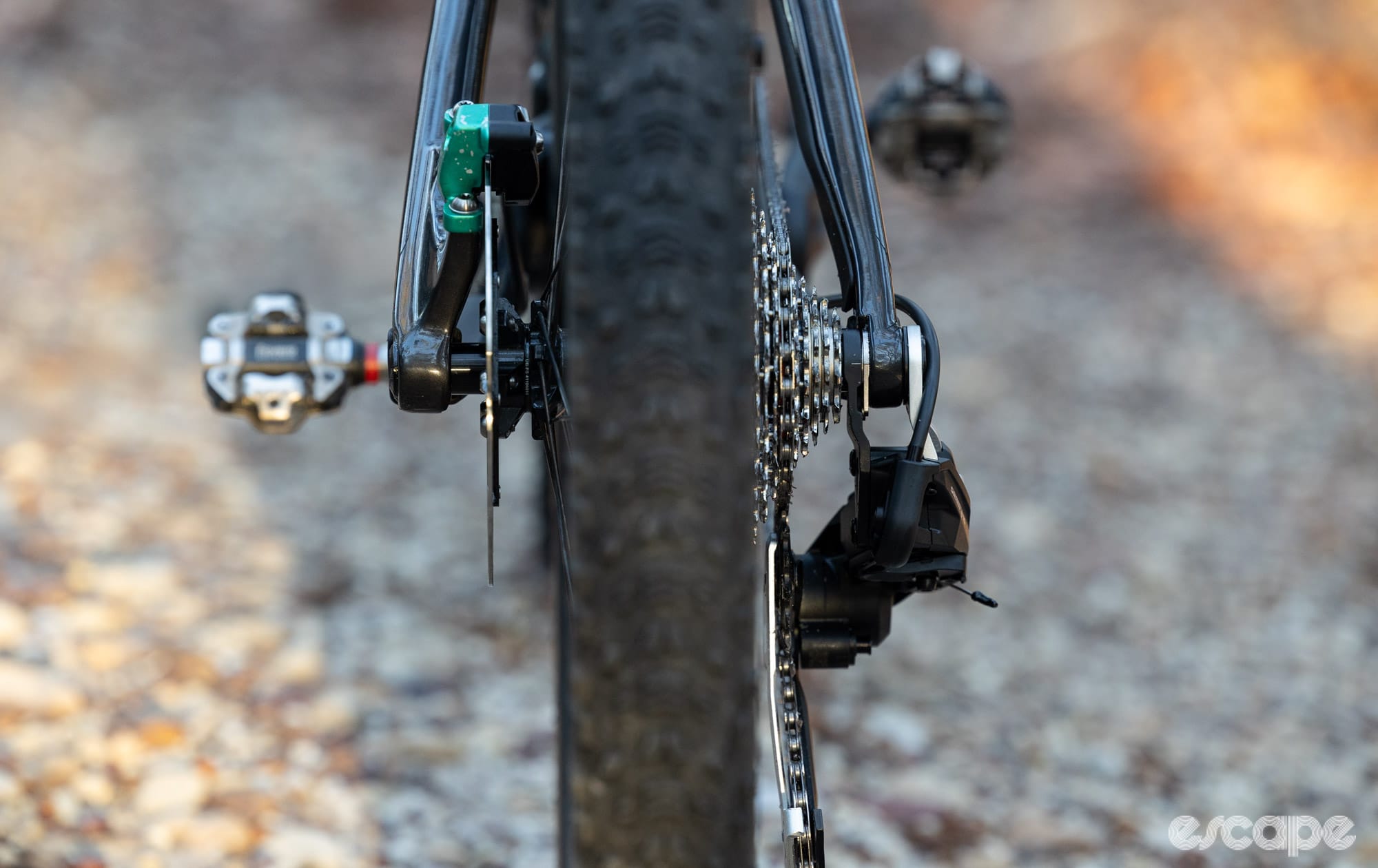
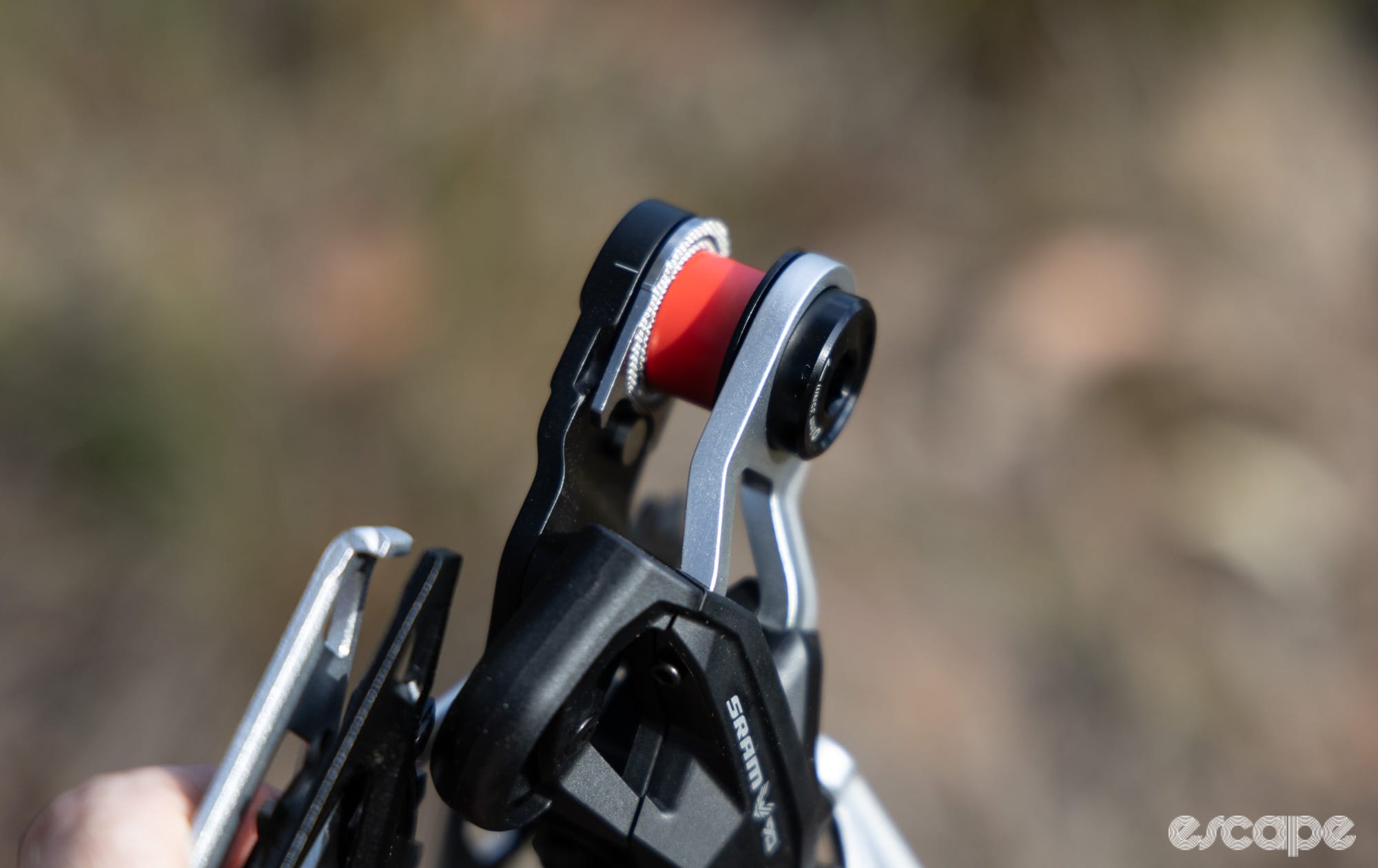
SRAM Full Mount sandwiches the frame dropout.
Directly mounting the derailleur to the frame provided SRAM with control for where exactly the rear derailleur sits in relation to the cassette in height and spacing, and with that, allowed them to rethink how a derailleur is installed and is (or isn’t) adjusted. Transmission derailleurs have no limit screws or way of fine-tuning the B-gap (derailleur height), rather, installation is all laid out as a step-by-step process based on the bike it’s going on and the chainring size of choice.
SRAM Transmission AXS has largely been a success in the market. It has just about dominated OE (Original Equipment) supply on many premium mountain bikes. It’s set a new benchmark for how controlled shifting can feel under full pedalling power. Meanwhile, early fears (not mine) of broken frames from impacts on a directly mounted derailleur have been proven to be unfounded, all while making bent hangers a dated-feeling problem.
Still, for all the good it offers (and there’s plenty!), SRAM Transmission AXS hasn’t been flawless. Complaints of shifter ergonomics are common. Some riders continue to complain that shifting across multiple gears is too slow – a feature that intentionally ensures a shift is completed before the next is activated. And while the derailleur and how it mounts to the frame has proven strong enough to stand on, kick, or bash with sledgehammers, the dangling derailleur cage is not immune to death by stick. And finally, while rare, battery connection issues with the AXS system do exist and seem to be on the rise. Still, across more than eight different bikes, it has been largely flawless for me (see my original review of XX SL which I haven’t had the need to update two years on).
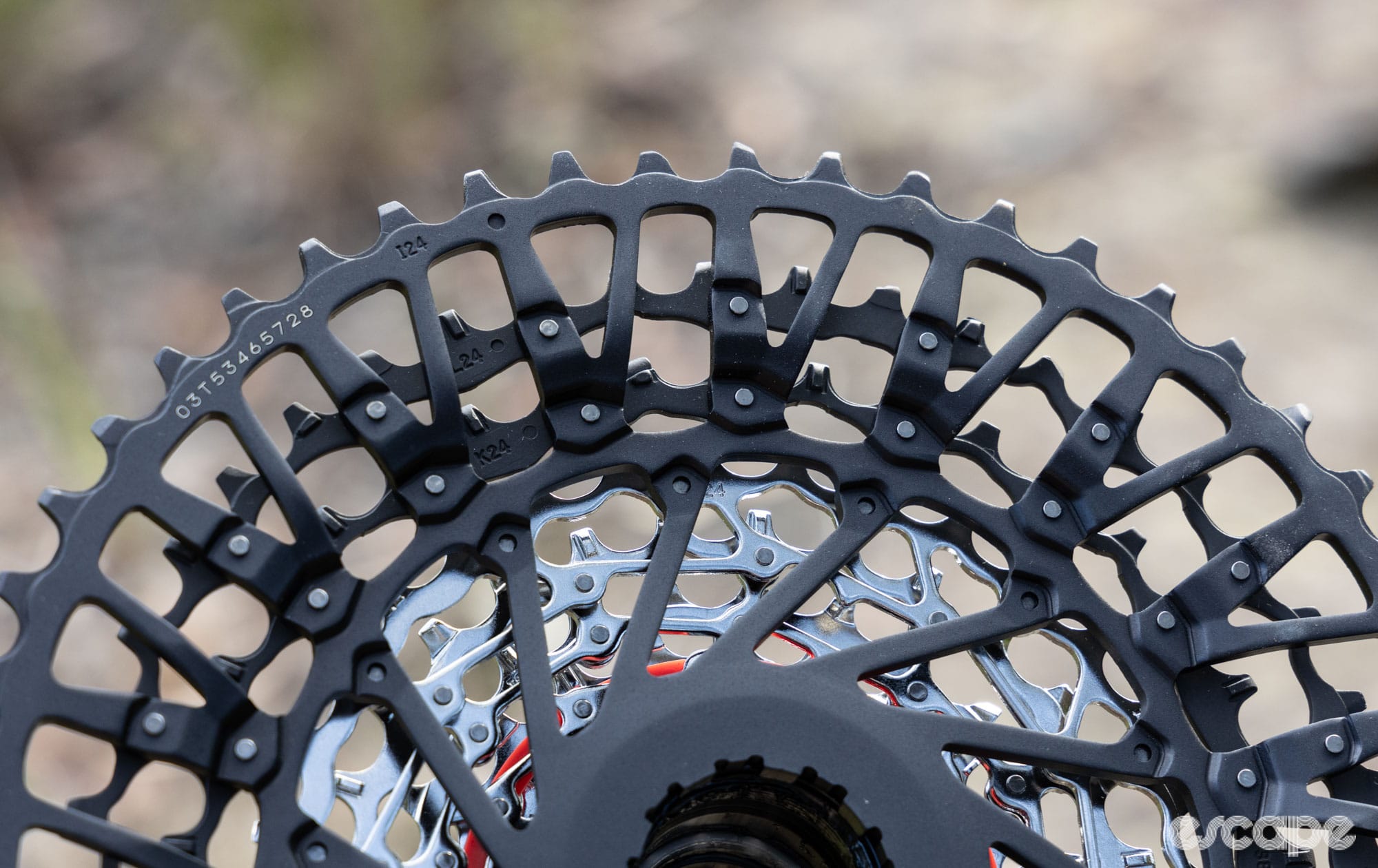
Finally, that brings us to Eagle Transmission, or as I call it, Eagle Mechanical Transmission. A system that aims to offer all the same strength improvements and shifting under load benefits of the AXS system, just without the batteries. However, as members of Escape will find out, it’s not as simple as that.
Eagle 90 and 70 explained
SRAM is returning to its use of easily understood numbers with these new lower-level parts. One benefit is differentiating the names from the mechanical Eagle groups (such as GX and NX) with traditional derailleurs that predate Transmission and remain available, while another reason is that it allows bike brands to more easily mix and match across price points. Aesthetically speaking, the new 90 and 70 parts also stick to black, again, to make them more easily interchangeable with each other. Transmission 90 is the more premium mechanical Transmission offering of the two. It’s priced and built to sit below the current Transmission GX AXS, with a number of parts in common. In fact, the 90-series Flattop chain is a GX T-type chain, while the cassette is the same XS-1275 10-52T model that mounts to an XD driver body, just with a refreshed finish.
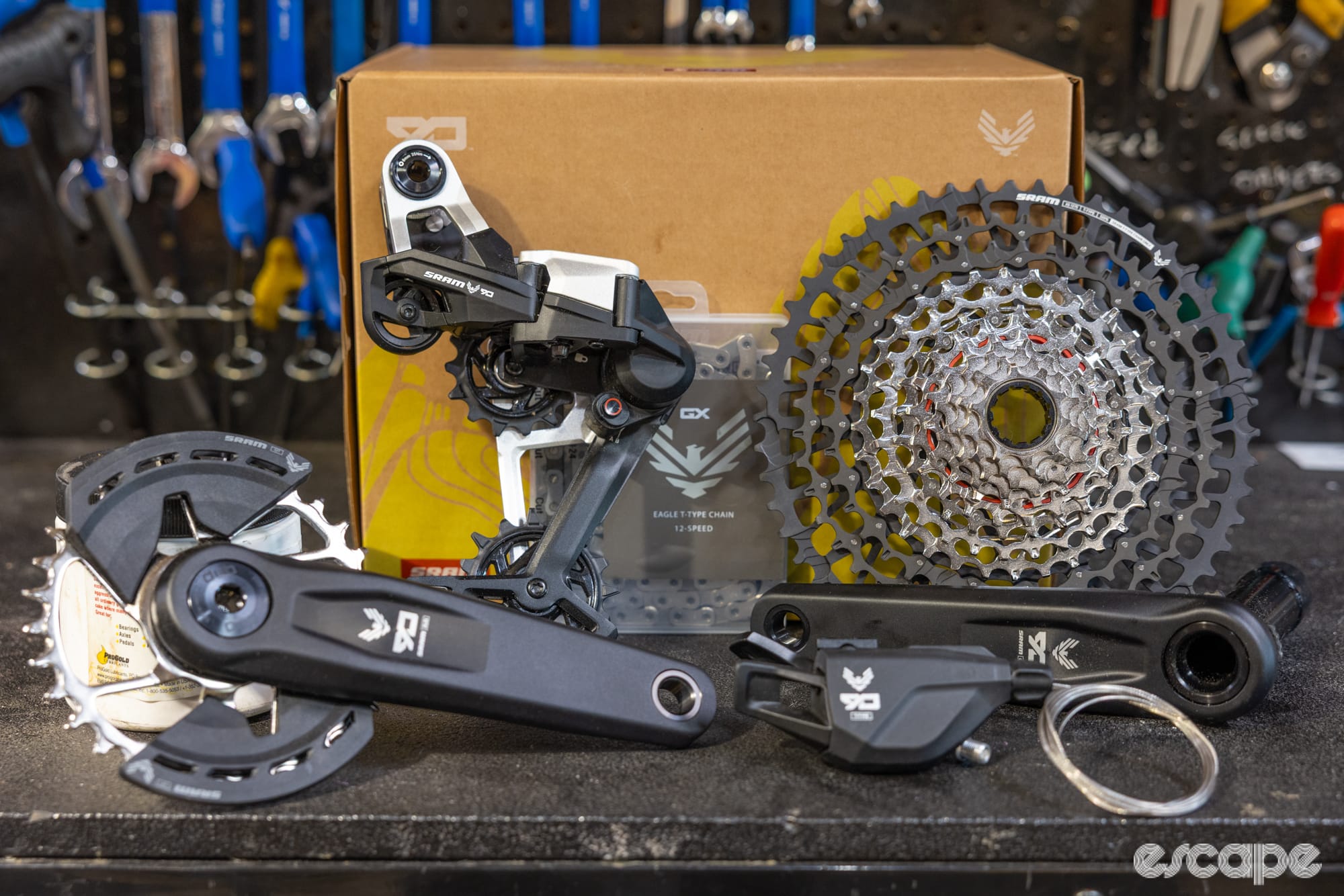
That all-new rear derailleur gets its own section below, but for now, it’s worth noting that it’s a ground-up redesign in order to work with a cable instead of a servo motor and battery. The cable routing is similar to previous generation Eagle mechanical, while the rest of the derailleur is more akin to Transmission AXS – including the total lack of adjustment screws.
I’ll also come back to the all-new T-Type trigger shifter that pulls the derailleur with a cable pull ratio that’s different to everything else in SRAM’s lineup. At the 90-level, it’s a burly full full-aluminium item with a textured paddle.
Compared to GX Transmission AXS, some subtle material differences can be detected on the scale and with a sophisticated testing instrument, otherwise known as a magnet. The forged alloy crank arms (available in 155-175 mm lengths) are also shared with GX and stick with SRAM’s newer 8-bolt chainring mounting pattern. Similarly, the provided (but removable) bashguards are the same as GX and XO. However, the aluminium spindle is heavier, the bolt is steel versus aluminium, and there is the option between a lighter machined aluminium chainring in black or a heavier stamped steel chainring in silver (tested). Of course, the 90-series crank is heavier, but as previously written about, that steel bolt will make the crank easier to remove and the steel chainring will be more durable, too.
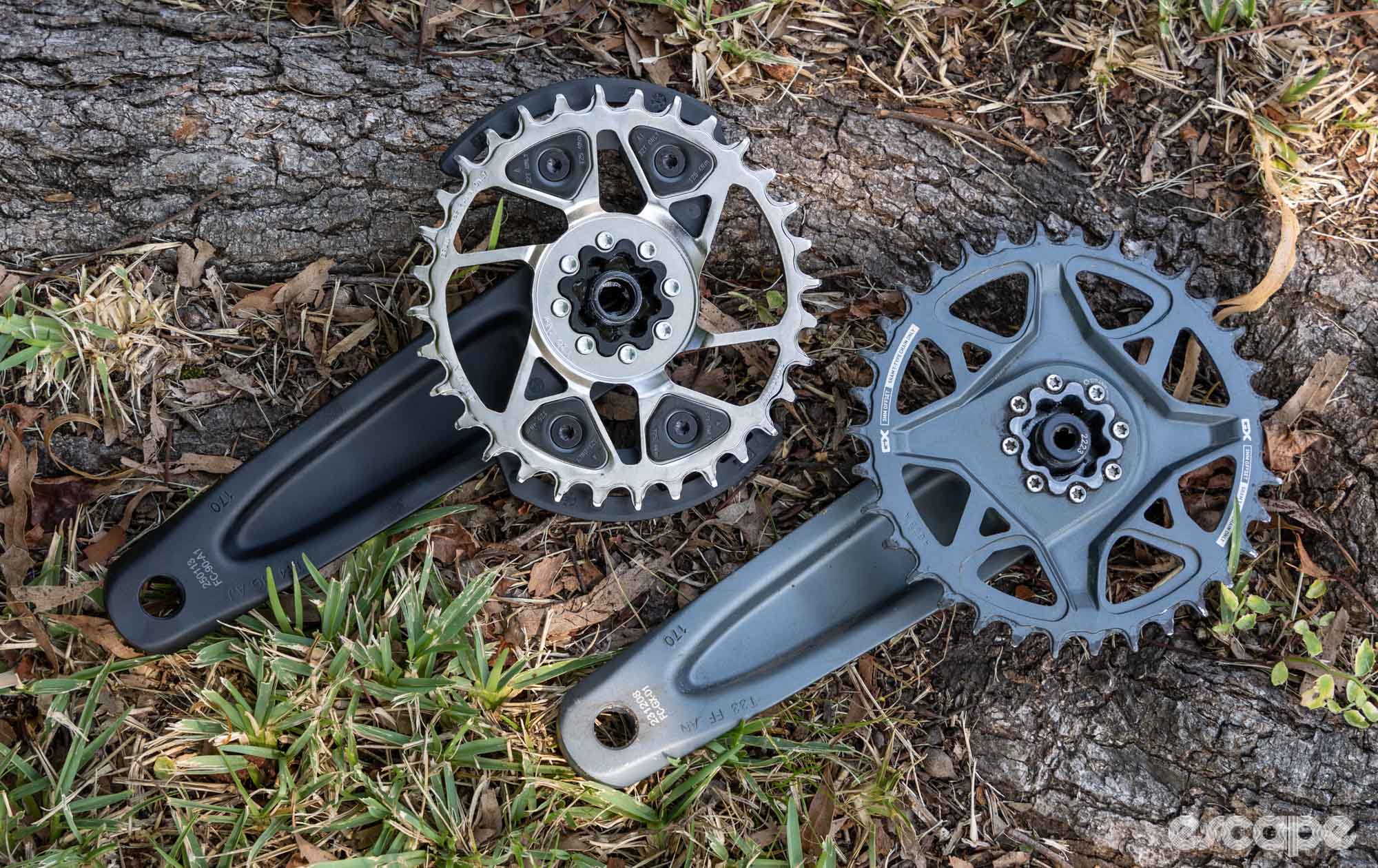
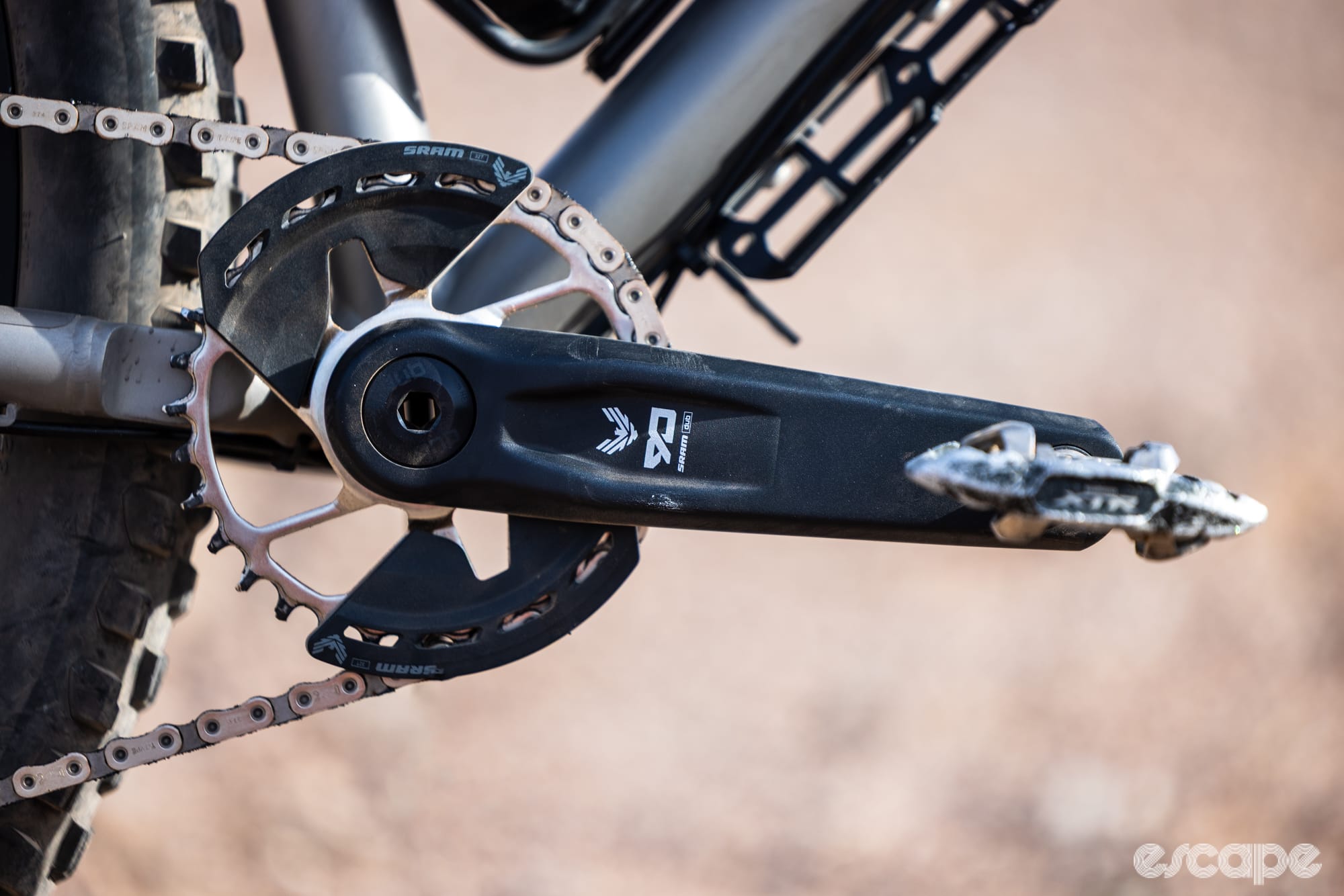
The cranks are close, but not exact (black crank is 90 Transmission, grey is GX Transmission). Pictured on the right are the provided bashguards, which can be easily removed if you wish to save 76 grams.
Sitting at a cheaper price point, the 70-series is designed expressly with OE demand in mind; expect to see this mostly equipped on more price point-oriented bikes. Here, each part is marginally heavier to save cost over the 90-series. In many ways, it’s a mechanical version of SRAM’s S1000 Transmission, which was introduced last year as a OE-specific option priced below GX.
The rear derailleur features more steel, a simpler chain damper, and is marginally less rebuildable. The shifter gets a simpler bar mount clamp, plus a composite lever instead of the 90’s alloy. And the crankset moves to SRAM’s older 3-bolt chainring pattern, along with a cheaper alloy spindle (6000 versus 7000-series aluminium).
One fancy piece is the XS-1270 10-52T cassette that was introduced with S1000 Transmission. It cleverly attaches to a common Shimano HG-style freehub and offers a separately replaceable section of smaller cogs that are more likely to wear more rapidly on an e-bike. While a 10T cog can’t normally be installed on an HG freehub, SRAM overhangs it off the edge, with extra clearance given by the Full Mount derailleur. Meanwhile, the Flattop chain is new, and features a cheaper grey finish while still offering Hard Chrome coated pins – while SRAM hasn’t confirmed it, it sounds a lot like the Apex chain.
It’s also worth mentioning that SRAM has released a mechanical dropper lever to match the ergonomics and styling of its new shifters – expect to see this equipped on some bikes. The American company also has a range of e-bike-specific cranks, along with required single-click shifter for those motor-assisted bikes.
Weights and pricing
Weight-wise, SRAM Eagle 90 is close to GX AXS, especially if you choose an aluminium chainring. Weight is saved in the mechanical derailleur, but added back in the subtly different crank, mechanical shifter, and cables. See below for a breakdown of the weights I took of 90-series and GX AXS, plus (trusted) claimed weights for Eagle 70, Shimano XT M8100, and previous-gen Eagle GX. (Note: weight comparisons can be tricky given differing standards. The weights provided are chosen to be closely comparable, but expect a 30-50 gram swing from listed totals, depending on various factors).

Tech nerds may be pondering about lightening the 90-series group, and yes, you absolutely can. Whether mechanical or AXS, you can run any level of Transmission chain, crank, or cassette you please between the Transmission range. And, there’s nothing stopping you from easily upgrading the derailleur cage to carbon.
As for pricing, full Eagle 90 Transmission groupsets are available for US$670 / €730 / £655, with e-bike versions costing marginally less. For comparison, SRAM sells its GX Transmission AXS groupset for US$1,099. SRAM does not offer a full 70 Transmission groupset for aftermarket purchase.
I’ll keep it simple by just providing USD for comparison. SRAM typically runs on global pricing, so typically, a currency conversion will get you into the right ballpark for what these pieces will be worth locally.

Shimano pricing can have some variance to it, but from the prices I’ve seen, even XT M8100 is priced below that of Eagle 90-Series. In some aspects 90-Series is equivalent and even better than XT, while in other areas it’s much more a SLX-level product.
Up till now, I’ve shared information that I expect is largely provided in multiple places around the internet (except maybe the weight comparison). From here on I’ll be diving a level deeper and providing hands-on insight, and for that, you’ll need to click that Join button at top right and become a member of Escape Collective (the only way we fund this whole thing).
The rear derailleur is cool
Identical to Transmission AXS, there’s a tool-free cage assembly with an integrated chain damper that merely twists into the derailleur body (the chain and friction stop it from untwisting). You can take any cage assembly from within the Transmission line and simply slap it into either the 90 and 70 derailleurs.
Did we do a good job with this story?

